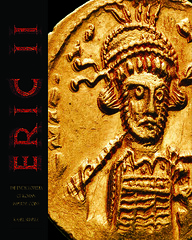
PREV ARTICLE
NEXT ARTICLE
FULL ISSUE
PREV FULL ISSUE
AN INTERVIEW WITH ERIC II AUTHOR RAS SUAREZ
The Reader Views web site has an excellent (and lengthy!) interview with Ras Suarez, author of ERIC II: The Encyclopedia of Roman Imperial Coins. Here are some excerpts I think will be of particular interest to researchers and bibliophiles, but I encourage everyone to read the full interview or listen to the audio.
-Editor
Rasiel Suarez is a specialist in ancient Roman coins. As a child he collected stamps and coins, like many other kids his age, but eventually left these collections dormant despite retaining an avid interest in history and geography. This interest eventually led to a Bachelor's in Political Science from the University of Rhode Island. During the 90's, trips to Europe, and later the advent of eBay, rekindled his interest in coins. In 2002, he and his wife founded Dirty Old Coins, a company that brought the hobby to thousands of mainstream families throughout the world. In 2005 the release of "The Encyclopedia of Roman Imperial Coins" (ERIC for short) was well received by fans of the series and the initial run sold out soon after. November of 2010 saw the publishing of "ERIC II," the fully revised and long awaited sequel, which promises to be a landmark achievement in Roman numismatics. The author lives with his family in Olympia, Washington. Tyler: Welcome, Rasiel. As a coin collector myself, I'm excited to interview an author who knows a lot about coin collecting. To get started, will you tell us a little bit about how you got started with coin collecting?
Tyler: What made you decide to write a book about Roman Imperial Coins? Rasiel: Back then there was relatively little up-to-date information about the coins and efforts to bring what there was into the digital age had just begun. I had gotten a number of books and visited some of these earlier websites but had that inner conviction that I could do better myself. I didn't know I was going to write a book yet, but I had begun the initial phase of research by putting together a huge database of coins from past sales and then published this initial effort online. It proved to be a good starting point from which to take the project offline in the form of a book which could be used by anyone with a passing interest in Roman coins, as opposed to a scholar or an advanced collector. The first edition took two years to complete as I found time in between work and family. The second edition, however, consumed just about every waking hour of my life for the next five years! Tyler: I admit I was a bit confused by the title ERIC II at first, but then realized it's an acronym for "Encyclopedia of Roman Imperial Coins" which is the subtitle. And the II is because it's the second edition. What additions or changes have been made from the first edition? Rasiel: Initially, I did have in mind more modest goals for a second edition. There were many editing errors and the catalog was very basic. I had in mind to correct the errors and bring it a degree closer along the road of being fully comprehensive. However, I became disillusioned with this plan since deep down what I really wanted was to author a definitive reference, one I would use instead of any other. Except for sections of the introduction and the general format, this second edition is essentially remade from the ground up and includes new features which were asked for by the collecting community whom I constantly engaged. It is also the first time a Roman coin book includes a full survey of the coinage of the Byzantine Empire. Tyler: Why did you decide to create an "encyclopedia" of Roman Imperial Coins? I assume that "encyclopedia" means it covers far more than just a Roman coin collecting book would cover? Rasiel: Well, honestly, it was just a handy acronym in honor of my first son Eric. But, with the goal of trying to include everything relevant about the emperors and their coins, not many other suitable titles came to mind. The Roman Coin Bible? Roman Coins for Dummies? Too hackneyed. Tyler: Has Roman coin collecting been popular for a long time, or has it only been in recent years that more people have grown interested in Roman coins? Rasiel: A Roman historian noted that Augustus himself had taken an interest in coins as keepsakes and would hand them out to friends and dignitaries. The evidence on the coins themselves suggest that while the majority were intended as nothing but cash, a few were issued in such limited quantities and with such care of manufacture that they were every bit the equivalent of modern presentation pieces meant to be kept rather than spent. Tyler: I can only imagine how much work went into this book, not just in research, but layout, photographs, printing. What was the most challenging part of writing and producing "Eric II"? Rasiel: Those long lists of coins that often stretch across a dozen pages or more were, I'm not going to lie, pure hell. Imagine writing something like a phone book from scratch except that for each new number you put down, you have to verify the information and do a number of cross-references to other numbers. And if you add an out-of-sequence number or find an error, all the rest of the numbers have to be updated. That's a fairly close analogy. Since my second son is autistic, perhaps his mother's dry observation that I am as well has some weight. How else to explain my ability to compile these lists day after day after year? The bios and the pics were a piece of cake, the reward for completing the list on each section! Tyler: Do you foresee "ERIC II" becoming an ebook in the future, which would allow for the color to be retained while reducing the printing costs? Rasiel: It's one of my most asked questions and I want to say yes. Even though the data files are nearly a gigabyte, making for one mammoth ebook, there are no major technical challenges to overcome. As a proof of concept, the pdf's are currently being reviewed on an iPhone, and I expect that further development can enhance the experience. As a business venture it remains to be seen whether, when, and how this should be done.
To read the complete article, see:
Interview with Rasiel Suarez
(readerviews.com/InterviewSuarez.html)
The Numismatic Bibliomania Society is a non-profit organization promoting numismatic literature. See our web site at coinbooks.org. To submit items for publication in The E-Sylum, write to the Editor at this address: whomren@gmail.com To subscribe go to: https://my.binhost.com/lists/listinfo/esylum All Rights Reserved. NBS Home Page Contact the NBS webmaster 
|

